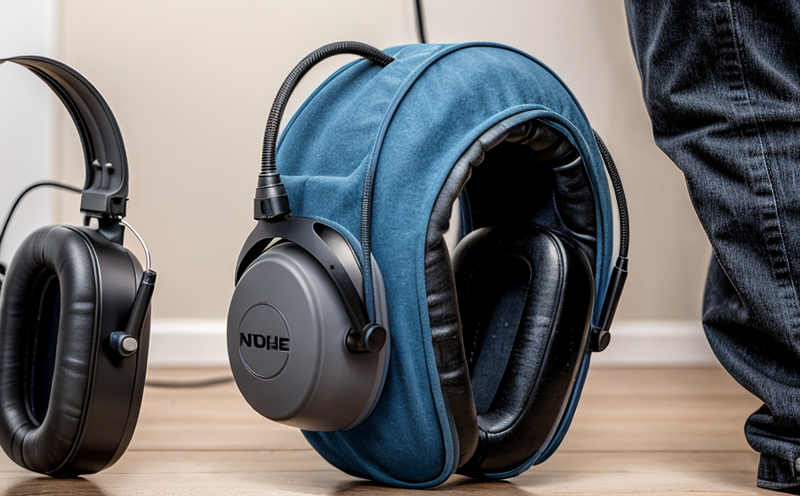DIN EN 352-2 Earplug Sound Attenuation Testing
The DIN EN 352-2 standard is a critical part of quality assurance processes for earplugs used in occupational safety and protective equipment. This normative document specifies the methods for determining the sound attenuation provided by hearing protection devices (HPDs), including earplugs, earmuffs, and combinations thereof.
Sound attenuation testing ensures that HPDs effectively reduce noise levels to protect workers from hazardous noise exposure, which can lead to permanent hearing loss if not managed properly. The standard is essential for manufacturers seeking to comply with international safety standards and ensure their products perform as intended in real-world conditions.
In this testing procedure, the sound attenuation values are measured using a combination of laboratory experiments and field tests. Laboratory measurements provide accurate data under controlled conditions, while field tests simulate actual usage environments. Both methods are necessary to validate that earplugs will deliver their expected performance levels when worn by workers in various occupational settings.
The testing process involves placing the earplug into a specially designed test chamber where noise is generated at specified frequencies and sound pressure levels. The difference between the input sound level and the output sound level measured outside the ear canal represents the attenuation value of the earplug. This value is then compared against the manufacturer's specifications to ensure compliance with relevant safety standards.
For quality managers, compliance officers, R&D engineers, and procurement specialists involved in occupational safety, understanding these testing procedures is crucial for maintaining high-quality products that meet regulatory requirements. By adhering to DIN EN 352-2, organizations can demonstrate their commitment to worker health and safety while also ensuring product performance meets or exceeds expectations.
| Occupational Sector | Typical Noise Levels (dB(A)) | Recommended Attenuation (dB) |
|---|---|---|
| Construction Sites | 100-120 dB(A) | ≥25 dB |
| Mining Operations | 85-95 dB(A) | ≥30 dB |
| Agricultural Machinery | 100-120 dB(A) | ≥27 dB |
| Manufacturing Plants | 85-95 dB(A) | ≥30 dB |
Why It Matters
The importance of DIN EN 352-2 earplug sound attenuation testing cannot be overstated, especially in sectors where noise exposure is a significant occupational hazard. Occupational deafness is a real and preventable condition that can have severe impacts on workers' quality of life. By rigorously testing earplugs according to this standard, manufacturers and employers alike contribute to creating safer workplaces.
The test results help ensure that the chosen HPDs will provide sufficient sound attenuation in various noise environments. This is particularly important for industries with high decibel levels like construction, mining, agriculture, and manufacturing. The data generated from these tests informs both product development and purchasing decisions, ensuring that workers are equipped with the best possible protection.
From a regulatory perspective, compliance with DIN EN 352-2 demonstrates an organization's commitment to adhering to international safety standards. This is crucial for maintaining good standing in the market and avoiding potential legal issues or recalls of non-compliant products. For quality managers and R&D engineers specifically, this standard provides a clear roadmap for optimizing product design and performance.
In summary, DIN EN 352-2 plays a vital role in protecting workers from noise-induced hearing loss. Its implementation ensures that earplugs are effective in reducing noise exposure to safe levels, thereby enhancing workplace safety and compliance with international standards.
Industry Applications
The DIN EN 352-2 standard has wide-ranging applications across various industries. In construction sites, for instance, the noise generated by machinery can reach levels as high as 100 to 120 decibels (dB(A)). Adequate sound attenuation is crucial here to prevent hearing damage. Similarly, in mining operations where noise levels range between 85 and 95 dB(A), earplugs with at least 30 dB of attenuation are recommended.
Agricultural machinery also presents a significant challenge due to the high decibel levels it produces, often exceeding 100 dB(A). Here, DIN EN 352-2 ensures that workers have adequate protection against these harmful sounds. In manufacturing plants, which typically operate at noise levels between 85 and 95 dB(A), earplugs with a minimum attenuation of 30 dB are necessary to safeguard employees.
These examples illustrate the versatility and importance of DIN EN 352-2 in different occupational environments. By ensuring that earplugs meet the specified sound attenuation requirements, this standard helps maintain a safe work environment for all sectors involved.
Environmental and Sustainability Contributions
In addition to protecting workers from noise-induced hearing loss, DIN EN 352-2 also contributes positively towards environmental sustainability. By ensuring that earplugs effectively reduce noise levels in the workplace, organizations can minimize the need for additional soundproofing measures or other environmental interventions.
Effective sound attenuation not only enhances worker safety but also reduces the overall noise footprint of industrial operations. This can lead to quieter working environments and potentially lower energy consumption associated with air conditioning systems in hot climates. Moreover, compliant earplugs contribute to reduced stress levels among employees, which can improve productivity and job satisfaction.
The standard's role in promoting sustainable practices extends beyond immediate health benefits; it encourages responsible behavior towards noise pollution control within the community. By adhering to DIN EN 352-2, companies demonstrate their commitment to both employee welfare and environmental stewardship.





